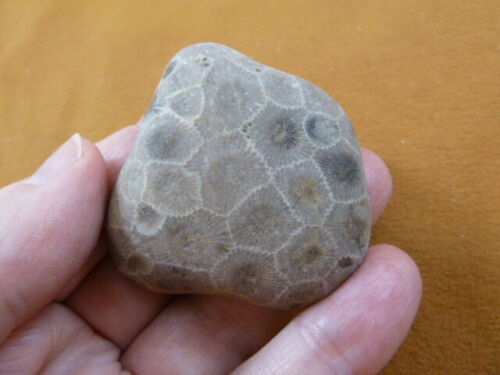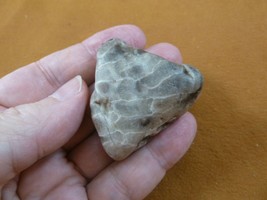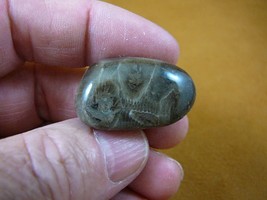(F831-362) 2" unpolished Petoskey stone and 32 similar items
Free Shipping
(F831-362) 2" unpolished Petoskey stone fossil coral specimen MI state rock
$19.62
View full item details »
Shipping options
Estimated to arrive by Thu, May 8th.
Details
FREE via USPS Ground Advantage (2 to 3 business days) to United States
Offer policy
OBO - Seller accepts offers on this item.
Details
Return policy
Full refund available within 30 days
Purchase protection
Payment options
PayPal accepted
PayPal Credit accepted
Venmo accepted
PayPal, MasterCard, Visa, Discover, and American Express accepted
Maestro accepted
Amazon Pay accepted
Nuvei accepted
View full item details »
Shipping options
Estimated to arrive by Thu, May 8th.
Details
FREE via USPS Ground Advantage (2 to 3 business days) to United States
Offer policy
OBO - Seller accepts offers on this item.
Details
Return policy
Full refund available within 30 days
Purchase protection
Payment options
PayPal accepted
PayPal Credit accepted
Venmo accepted
PayPal, MasterCard, Visa, Discover, and American Express accepted
Maestro accepted
Amazon Pay accepted
Nuvei accepted
Item traits
| Category: | |
|---|---|
| Quantity Available: |
Only one in stock, order soon |
| Condition: |
New |
| Material: |
Stone |
| Country of Manufacture: |
United States |
Listing details
| Shipping discount: |
Seller pays shipping for this item. |
|---|---|
| Posted for sale: |
More than a week ago |
| Item number: |
1394260003 |
Item description
(Internal # F831-362) This is a large, genuine Petoskey fossil coral stone, unpolished specimen, average 2" long.
Petoskey stones are a gray color; coated with baby oil to show off pattern.
What you see in to photo is what you get.
PETOSKEY STONES
THE ROCK THAT'S ACTUALLY A FOSSIL!
(Fossil coral, Hexagonaria percarinata)
This is fossil coral, with a beautiful honeycomb pattern, fairly soft at Mohs 3 on the hardness scale. Michigan's State Rock. Antrim County MI holds a Petoskey Festival each year. Formed when Michigan was covered by a sea in which coral reefs thrived, the coral gradually became buried by sediment, which turned into limestone and shale. The skeletons were replaced by calcite (calcium, carbon oxygen).
The soft living tissue of the corallite was called polyp. At the center of the polyp was the food intake opening or mouth. This dark spot, or the eye of the corallite, has been filled with silt or mud that petrified after falling into the openings. Surrounding the opening were tentacles that were used to gather food and draw the food into the mouth. The living corallite thrived on plankton which lived in the warm sea. The Petoskey stone is also known as a colony coral.
During the Ice Ages, from 1.6 million to 10,000 years ago, glaciers scraping over Michigan broke up soft, fossil-bearing rocks. The pieces were carried along and dropped, now found along lake beaches, road cuts, and gravel pits as rounded stones from pebble size to potato-sized lumps. Dated to 350 million years old (Devonian period). Found on the shores of Little Traverse Bay from the northwestern tip of the Lower Peninsula, especially around Petoskey and Charlevoix, Michigan.
The name "Petoskey" comes from an Ottawa Indian chief. When he was born, sunbeams fell upon his face so he was named Pe-tos-e-gay ("rising sun"). European settlers Anglicized the name as Petoskey.
WE SHIP WORLDWIDE, see the chart for postage to your country.
Click on our Store tag for SIMILAR items.
PETOSKEY STONES ARE A GRAY COLOR.
|
Why are we showing these items?
Booth
whereonearth's booth |
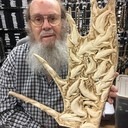
|

-
Refine your browsing experience
We can show you more items that are exactly like the original item, or we can show you items that are similar in spirit. By default we show you a mix.
This item has been added to your cart
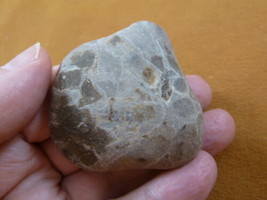 (F831-362) 2" unpolished Petoskey stone fossil coral specimen MI state rock added to cart.
Only one available in stock
(F831-362) 2" unpolished Petoskey stone fossil coral specimen MI state rock added to cart.
Only one available in stock
View Cart or continue shopping.
 Please wait while we finish adding this item to your cart.
Please wait while we finish adding this item to your cart.
Get an item reminder
We'll email you a link to your item now and follow up with a single reminder (if you'd like one). That's it! No spam, no hassle.
Already have an account?
Log in and add this item to your wish list.





